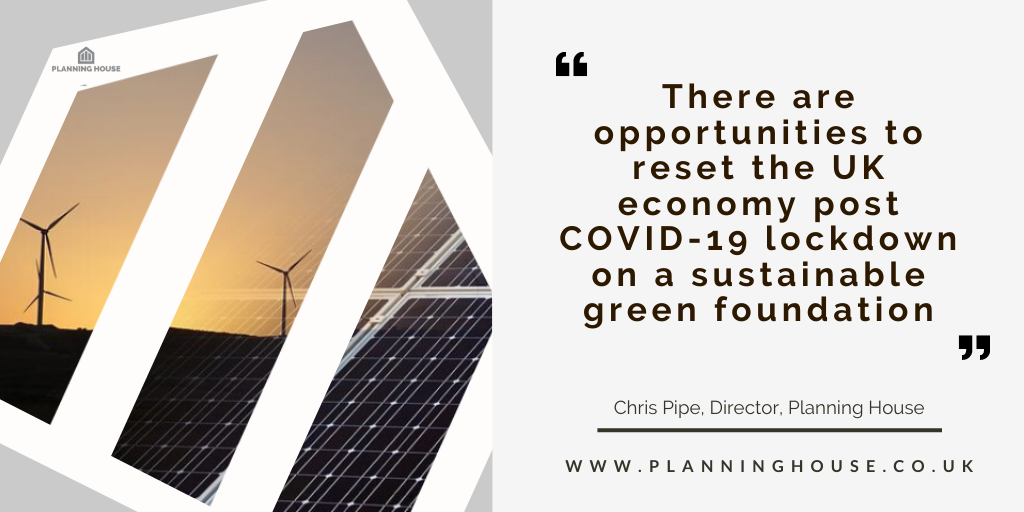As lockdown restrictions are eased and the nation starts to arrive at a ‘new normal’, economists and environmentalists alike are arguing the economic stimulus plan could (and should) give renewable energy a greater role in powering the country’s recovery. To control the spread of coronavirus (COVID-19) the economy essentially had to come to a stop; meaning the cost of the crisis, and the subsequent recovery, is enormous.
The companies harnessing energy from the sun, wind and sea hold the potential to stimulate the UK’s economy by attracting billions in investment and creating thousands of ‘green jobs’ whilst also helping to meet carbon reduction targets.
With mass office closures and only essential retail open for business at least initially, the UK’s power demand dramatically fell overnight even with the increase in at-home energy usage. Given this and the fact that on the 16th June the UK recorded its longest period without coal power (i.e. two consecutive months) since the industrial revolution, the National Grid took the opportunity to shut down the nation’s four remaining coal-fired power stations.
The current pandemic did of course not cause the decline in coal usage on its own, however, COVID-19 is almost certainly going to accelerate its demise. Along with natural gas power, local communities and politicians recognise the positive environmental impacts lockdown has caused and they want them to be maintained.
Significant change in the policy environment had nonetheless begun with the government’s Declaration of a Climate Emergency and establishing a legally-binding target to reduce greenhouse gas emissions to net zero by 2050 last year, as well as its more recent U-turn on opposition to subsidising new onshore windfarms. Such overarching commitments are an important step if renewables are to help support the country’s economic recovery, but there remains a lack of clarity at a national level for what the renewable energy need is and what the energy mix should be. Many hoped the draft National Energy and Climate Plan and Energy White Paper would ‘outline a roadmap to net zero’. Unfortunately, neither of these eagerly-awaited documents have been released as yet, and no publication dates are proposed regardless of several delays since late 2019.
That being said, it is also critical there is impetus from the local level if renewable energy schemes are to be delivered on the ground. The temporary perhaps somewhat disorientating green new reality caused by coronavirus (e.g. cleaner air, lack of congestion, and re-emerging wildlife) has increased the ground swell of climate change activism, which has gained growing territory across the media and in people’s hearts and minds; resulting in a noticeable shift in attitudes towards renewable energy. It seems to me that there is a growing majority who have a better understanding of the role renewables play in meeting carbon reduction targets and recognise their significant contribution to the national energy mix.
Such a shift in attitudes is significant particularly in relation to onshore wind which, in accordance with footnote 49 of the Framework, imposes a ‘community pass the test’ rule where local residents’ views are taken into account when considering the acceptability of environmental impacts of schemes.
In a plan-led system there also needs to be a policy framework at a local level to support and encourage appropriate renewable energy development; and unfortunately, such coverage is patchy across England.
If all local authorities are required to have an up-to-date plan by December 2023, now more than ever seems to be the time for the renewable energy sector to engage with local authorities proactively and early in the plan-making process. Equally, local authorities need to grapple with notion and decide if they are not minded to grant planning permission for carbon-based energy sources, what are they minded to approve based on the opportunities and constraints of their area?
In the UK there are substantial opportunities with ‘re-powering’ existing onshore windfarms, but in the absence of a clear definition, there is also a considerable challenge reaching agreement on what equates to appropriate development in this regard because re-powering does not necessarily mean the same size turbines in the same location. Effective communication between public and private sector and with local communities on such schemes will be crucial if the economic and environmental benefits are to be harnessed from such schemes and others. Again COVID-19 has inadvertently helped by making us all more familiar with and adept at digital engagement, which will better enable the views from a broader cross-section of society to be captured compared to more traditional consultation approaches.
Perhaps unsurprisingly carbon emissions have rebounded around the world as lockdown conditions have eased. For me, this stresses the importance of grasping the opportunities to reset the UK economy on a sustainable green foundation so that the benefits of the current situation do not slip away. If we’ve learned anything from lockdown, surely it is that most of us do not need to commute for work and there are alternative ways of working which are just as effective and save time, money and stress as well as carbon emissions.


